Zürich: A city and its trams
Chapter 1: Introduction, origins and growth
Zürich tram main page | articles list
table of contents | next chapter>
The pages of T&UT and its predecessor magazines have featured many articles on various aspects of Zürich, but a general discussion of the system as a whole has not been published in these pages for some time. As there is considerable interest in operations in Zürich among enthusiasts and professionals, the author hopes to use this article to fill in many of the gaps and give a general and broad introduction to Zürich and its success story.
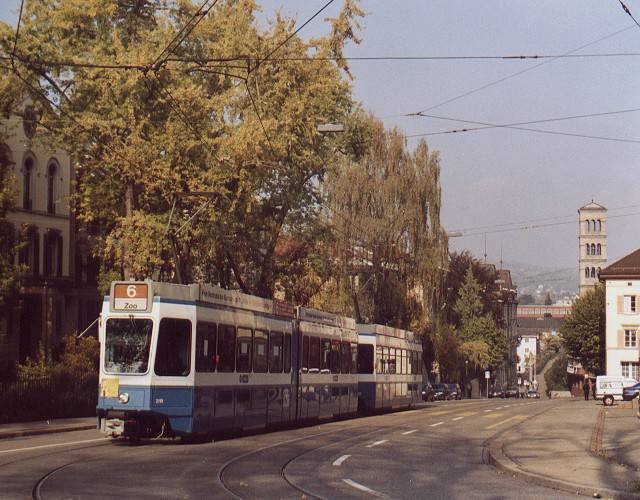 The city of Zürich counts some 330'000 inhabitants, and lies at the centre of a conurbation which, depending on how the boundaries are defined, may count over a million. Zürich's tram system has acquired an iconic status; 65% of people commuting within the city do so by public transport, with only 17% using cars [1]. Technocrats who associate cars with freedom and public transport with squalor must find it hard to explain that a study by the Mercer Institute in 2003 suggested that Zürich has the highest standard of living of any city in the world [2]. Public transport usage transcedes social divides. It is not uncommon to see high ranking business leaders, members of parliament or the city mayor travelling by tram (mostly without a bodyguard). Trams are also an iconic part of the city's identity - more than half of all picture postcards of the city feature a tram.
The city of Zürich counts some 330'000 inhabitants, and lies at the centre of a conurbation which, depending on how the boundaries are defined, may count over a million. Zürich's tram system has acquired an iconic status; 65% of people commuting within the city do so by public transport, with only 17% using cars [1]. Technocrats who associate cars with freedom and public transport with squalor must find it hard to explain that a study by the Mercer Institute in 2003 suggested that Zürich has the highest standard of living of any city in the world [2]. Public transport usage transcedes social divides. It is not uncommon to see high ranking business leaders, members of parliament or the city mayor travelling by tram (mostly without a bodyguard). Trams are also an iconic part of the city's identity - more than half of all picture postcards of the city feature a tram.
Remarkably, the system's success was achieved without sinking vast sums of money into megalomanic projects. As will be explained in this article, two successive attempts to build an underground were rejected. Zürich's trams have not even been granted a high proportion of fully segregated rights of way. There is only one tram subway and that only came to be because the tunnel was already there. Some stylish grass reservations have been built, but these are hardly common. Typically, only street markings keep cars off the tracks. In many places, roads are too narrow to allow even that and tram priorities are assured only by the phasing of traffic lights. Despite this seemingly minimal approach, timekeeping is very good and Zürich needs not shun comparison with the world's most punctual systems. Trams are prioritised at intersections, but Zürich recognises that speed alone is not the key to short journey times. Equally important are short walks to stops, short waits at those stops and good connections at interchanges. These benefits give Zürich real door to door journey times that compare very favourably with the rejected underground projects yet cost a fraction of the money to achieve.
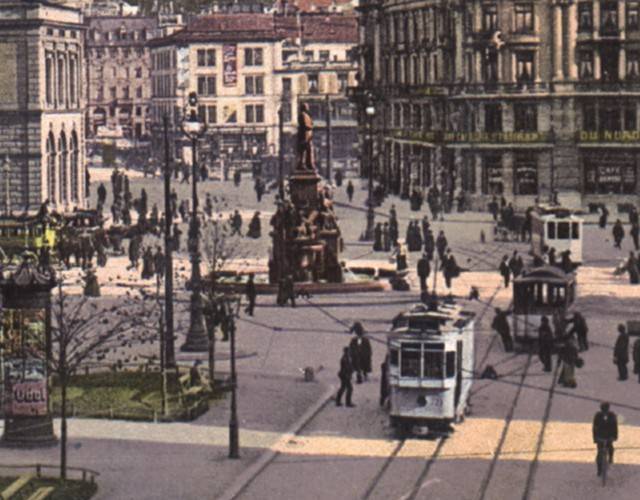 Transport is an important component of Zürich's past and present. Despite the city's rich heritage stretching from Roman times to the Middle Ages and the Reformation, the first sight that greets the visitor on leaving the railway station is the statue of a more recent dignitary: Alfred Escher. Escher was an industrialist and financier, but above all a railway promoter. No doubt he smiles approvingly at the endless stream of blue and white trams that passes his pedestal. Besides the infrastructure advantages that railways brought his city, local industry played an active role in the manufacture of equipment. A glance at the map will reveal neighbourhoods with names such as Oerlikon and Schlieren, names that the student of transport history will associate with products and technologies exported across the globe.
Transport is an important component of Zürich's past and present. Despite the city's rich heritage stretching from Roman times to the Middle Ages and the Reformation, the first sight that greets the visitor on leaving the railway station is the statue of a more recent dignitary: Alfred Escher. Escher was an industrialist and financier, but above all a railway promoter. No doubt he smiles approvingly at the endless stream of blue and white trams that passes his pedestal. Besides the infrastructure advantages that railways brought his city, local industry played an active role in the manufacture of equipment. A glance at the map will reveal neighbourhoods with names such as Oerlikon and Schlieren, names that the student of transport history will associate with products and technologies exported across the globe.
Interest in trams began relatively early. In the 1860ies, boats were still the principal means of transport along the lake shores. The railway station was unsatisfactorily far from the lakeside and a means was sought to suitably connect the old and new modes. In 1862, Genève opened Switzerland's first tram (and indeed mainland Europe's second!). The applicability of this mode became immediately apparent in Zürich; a first project was presented in 1863. This led to a length of track being installed on Limmatquai for demonstration purposes the following year. But the tram was not the only contender; inspired by London's newly opened Metropolitan Railway, a similar scheme was proposed in 1864. It was not the last time that the spectre of an underground was to threaten the tram. Neither project went ahead.
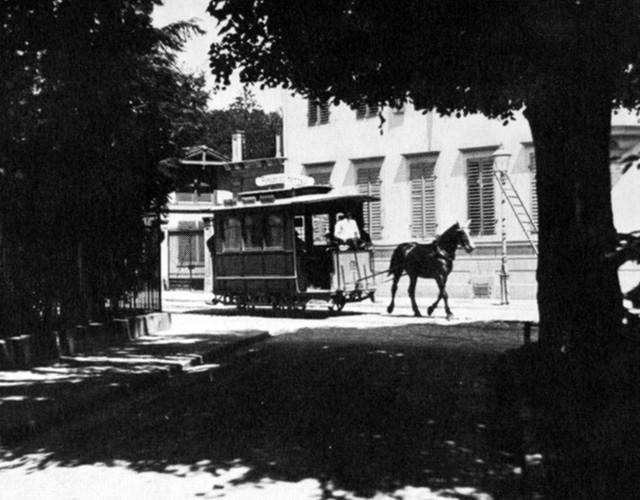 Zürich had to wait until 1883 for the first horse tram to run, and until 1894 for the first electric line. These tramways were built by private companies, but the city fathers soon awoke to the potential of trams. In 1896, Zürich wrote history by becoming the first European city to take over a tram company. The city did not have the powers to forcibly purchase companies and extensive negotiations were needed in every case. It took the city until 1931 to control all tram routes on its territory. Whilst acquiring these, the new city tram operator (StStZ [3]) was also upgrading routes and adding new ones. The panoply of private companies merged into a flourishing and integrated enterprise of which the city and its inhabitants were rightly proud. The fact that the majority of picture postcards of Zürich somehow feature a tram is no phenomenon of recent years!
Zürich had to wait until 1883 for the first horse tram to run, and until 1894 for the first electric line. These tramways were built by private companies, but the city fathers soon awoke to the potential of trams. In 1896, Zürich wrote history by becoming the first European city to take over a tram company. The city did not have the powers to forcibly purchase companies and extensive negotiations were needed in every case. It took the city until 1931 to control all tram routes on its territory. Whilst acquiring these, the new city tram operator (StStZ [3]) was also upgrading routes and adding new ones. The panoply of private companies merged into a flourishing and integrated enterprise of which the city and its inhabitants were rightly proud. The fact that the majority of picture postcards of Zürich somehow feature a tram is no phenomenon of recent years!
It was also an undisputed expression of municipal dignity that the blue and white colours of the city arms were applied to the municipal trams from the beginning. These colours still adorn the trams today, 109 years later!
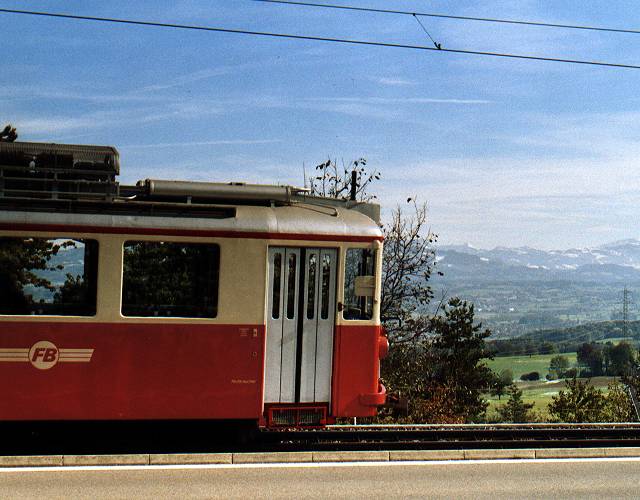 Whereas the private lines within the city boundaries had all been acquired by 1931, little interest was expressed in the extensive interurban network beyond. Traffic on this was low and the infrastructure often in a poor state. Additionally, the city council feared loss of tax revenue through breadwinners commuting from outside the municipality, and hence showed little interest in retaining tram lines that might enable them to do so. As some companies had operated both urban and interurban sections, several such lines did pass into city ownership. Many of these were cut back on being taken over. In later years, as satellite towns grew, the lost routes were sorely missed. As shall be seen later, many are set to return.
Whereas the private lines within the city boundaries had all been acquired by 1931, little interest was expressed in the extensive interurban network beyond. Traffic on this was low and the infrastructure often in a poor state. Additionally, the city council feared loss of tax revenue through breadwinners commuting from outside the municipality, and hence showed little interest in retaining tram lines that might enable them to do so. As some companies had operated both urban and interurban sections, several such lines did pass into city ownership. Many of these were cut back on being taken over. In later years, as satellite towns grew, the lost routes were sorely missed. As shall be seen later, many are set to return.
Some interurbans did struggle on, however, and two of these survive. They are (Zürich Stadelhofen) - Rehalp - Forch - Esslingen (Forchbahn) and Dietikon-Bremgarten-Wohlen (BDWM). The latter has been geographically isolated from the city since the closure of the Limmattal line in 1928. Thanks to the growth of Zürich's outer suburbs, both lines now have healthy traffic and their survival is secure.
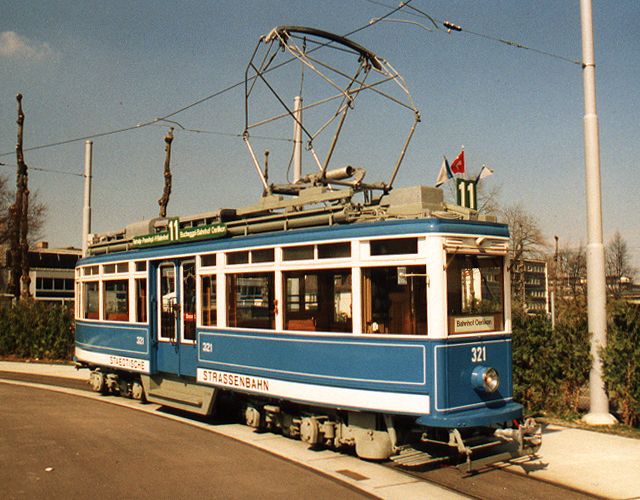 This article, however, is principally concerned with the urban system. Whereas some cities were already moving forwards in the 1920's by acquiring large bogie cars with passenger flow, Zürich was still relying heavily on wooden-bodied four wheelers, many inherited from private companies. 50 bogie cars (the famous Elefant type, 301-350 [4]) were acquired in 1929-30, but were still largely traditional in their construction. The situation was to be revolutionised by the end of the decade.
This article, however, is principally concerned with the urban system. Whereas some cities were already moving forwards in the 1920's by acquiring large bogie cars with passenger flow, Zürich was still relying heavily on wooden-bodied four wheelers, many inherited from private companies. 50 bogie cars (the famous Elefant type, 301-350 [4]) were acquired in 1929-30, but were still largely traditional in their construction. The situation was to be revolutionised by the end of the decade.
It was an age where modern materials and designs flowed into common life and where form combined with functionality. In Switzerland, the influence of architects and designers such as Le Corbusier were affecting the shape and feel of everyday objects. This revolution had not left tram makers and operators untouched. They looked for inspiration across the Atlantic to the PCC, but also to the examples of neighbouring Italy, and mixed these ideas with their own. A concept for a modern passenger-flow tramcar emerged. StStZ was, however, reluctant to place an order for even a prototype. The construction of new lines had practically ceased with most neighbourhoods now served by trams. Where demand for new services was identified, traffic was often low and the trolleybus considered more suitable.
The event that finally got the new tram onto the rails, was the Swiss National Exhibition (Landesausstellung or Landi) held in Zürich in 1939. Crowds were to flock to the city from all corners of the country for this hitherto unknown spectacle, presenting one of the biggest logistic challenges in Zürich's tram history. What better opportunity to show off a revolutionary design in action?
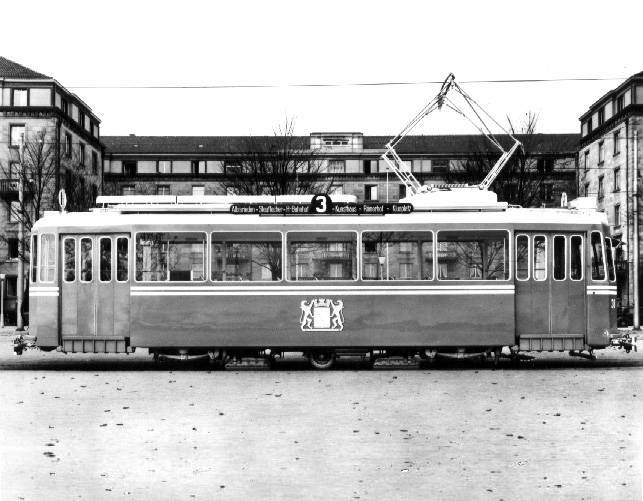 The objective was to have two prototypes in traffic during the exhibition. This was achieved, but at the price of a rushed design phase. The prototypes (31 and 32 [5]) ran on six-wheel radially adjusting trucks. The electrical equipment was of an old type with an insufficient number of controller notches. The jumpy riding qualities soon earned the cars the name of Geissbock (billy goat). For the first time in the city, passengers would board at the rear door and pass a seated conductor. The design, both inside and out, was clean, utilitarian, and in stark contrast to anything that had been seen in the city before.
The objective was to have two prototypes in traffic during the exhibition. This was achieved, but at the price of a rushed design phase. The prototypes (31 and 32 [5]) ran on six-wheel radially adjusting trucks. The electrical equipment was of an old type with an insufficient number of controller notches. The jumpy riding qualities soon earned the cars the name of Geissbock (billy goat). For the first time in the city, passengers would board at the rear door and pass a seated conductor. The design, both inside and out, was clean, utilitarian, and in stark contrast to anything that had been seen in the city before.
Before the prototypes were completed, the inadequacies of the design were already obvious. The third unit (351 [6]), arriving in 1940, was longer and had bogies [7]. The electrical equipment was state of the art and the ride quality stunning. A design had been born that was to shape the face, not only of Zürich, but of other Swiss tram systems for decades to come. In 1944, a conference of public transport operators declared this design the Swiss Standard Tram. Zürich took delivery of two variants. The PCC-inspired pedal-controlled design was for routes with light traffic. The more powerful hand-controlled version was for hauling trailers on the busier routes. These variants were called Pedaler and Kurbeli respectively after their driving techniques (Kurbel meaning hand controller).
It was 1940, and war was raging in Europe. Switzerland's neutrality kept the country clear of hostilities, but the loss of foreign markets, shortage of raw materials and the general mobilisation depressed the economy. Tramcars were subjected to blackout requirements and women called upon to work as conductors. Delivery of Standard Trams slowed.
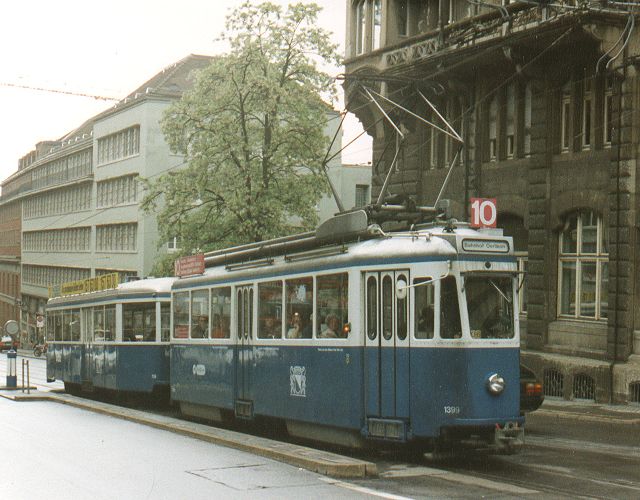 In the post war years, production of Standard Trams picked up again. Until 1954, Zürich was to take delivery of 177 Standard Trams (Kurbeli 1351-1415, Pedaler 1501-1552 and trailers 711-770). The Standard Tram brought about not only operational economies, but by providing attractive modern vehicles helped stave off the anti-tram tide that was to sweep over much of the rest of the world. Other Swiss cities soon ordered cars of their own. In 1947 first Standard Trams were delivered to Luzern and Bern, in 1948 to Basel and in 1950 to Genève. Many of these cars provided over 50 years of service. Second hand cars were to migrate from Luzern to Genève, from Zürich and Basel to Bern, and further afield, from Genève to Sibiu, Zürich to Pyongyang, Basel to Beograd and from Bern to Iasi. At the latter locations many are still running today. But even in Zürich, this type is not history yet: many trailers are still used and 4 Kurbelis are works cars [8].
In the post war years, production of Standard Trams picked up again. Until 1954, Zürich was to take delivery of 177 Standard Trams (Kurbeli 1351-1415, Pedaler 1501-1552 and trailers 711-770). The Standard Tram brought about not only operational economies, but by providing attractive modern vehicles helped stave off the anti-tram tide that was to sweep over much of the rest of the world. Other Swiss cities soon ordered cars of their own. In 1947 first Standard Trams were delivered to Luzern and Bern, in 1948 to Basel and in 1950 to Genève. Many of these cars provided over 50 years of service. Second hand cars were to migrate from Luzern to Genève, from Zürich and Basel to Bern, and further afield, from Genève to Sibiu, Zürich to Pyongyang, Basel to Beograd and from Bern to Iasi. At the latter locations many are still running today. But even in Zürich, this type is not history yet: many trailers are still used and 4 Kurbelis are works cars [8].
When the last Standard Tram was delivered to Zürich in 1954, the modernisation of the fleet was far from complete. In fact new cars were still outnumbered by older types. Why did the modernisation programme take such an abrupt turn?
table of contents | next chapter>
Zürich tram main page | articles list
Footnotes:
[1] Of the 125'000 people who both live and work in the city of Zürich, 65% travel to and from work by public transport, 17% use a car, 10% a bicycle and 6% walk all the way. Statistik Stadt Zürich, 25th September 2003.
[2] On March 3rd 2003, Mercer Human Resource Consulting (London) published the result of a study comparing the standards of living in 215 cities of the world, judging them by 39 criteria reflecting political, social and economic factors. Zürich came top of the list, followed by Wien, Vancouver, Genève, Sydney, Frankfurt, München, Auckland, Copenhagen and Bern. The high incidence of tram cities is astonishing!
[3] StStZ (Strassenbahn der Stadt Zürich ), name of the municipal tram operating body from 1896 to 1950.
[4] In 1947 all motor cars were renumbered by adding 1000 to their numbers. Thus 301 became 1301.
[5] Renumbered 1031/2 in 1947.
[6] Renumbered 1351 in 1947.
[7] This was not the end of the line as far as the six-wheel radial truck design was concerned. An improved version of the design was licensed by SLM to Werkspoor and was used for Amsterdam six wheelers 491-550 (built 1948-50).
[8] One of these, 1922 (ex 1351, the first Standard Tram) was given a new lease of life as Cargotram in 2003 (see T&UT August 2003, or the web version).
<previous footnotes | footnotes continued>
last updated: 14.12.05
counter added: 14.12.05